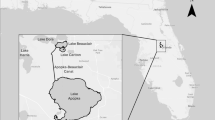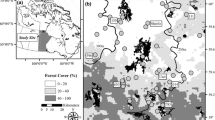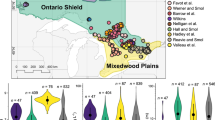Abstract
The surface sediment diatom and chrysophyte assemblages from 33 Sudbury lakes were added to our published 72 lake data set to expand and refine the diatom and chrysophyte-based inference models that we had earlier developed for this region. Our calibration data set now includes 105 lakes, representing gradients for multiple environmental variables (e.g., lakewater pH, metals, and transparency). The revised models are based on the weighted averaging calibration and regression approach and include bootstrap error estimates. The pH model was the strongest (r2 boot = 0.75, RMSE boot = 0.50). The chrysophyte-inferred pH model (r2 boot = 0.79, RMSE boot = 0.48) that we developed was as robust as the diatom pH model. Diatom and chrysophyte inferred pH models were then applied to ‘top’ (surface sediments representing current conditions) and ‘bottom’ (generally from > 30 cm deep representing pre-industrial conditions) sediment diatom and chrysophyte assemblages of 19 Killarney area lakes near Sudbury. The top and bottom inferred pH results were compared to early-1970s measured pH data. These data suggest that, although many of the poorly buffered Killarney lakes had experienced acidification, marked pH recovery has occurred in many lakes within the last 25 years. Despite the stunning pH recovery, the present-day diatom and chrysophyte assemblages are significantly different from assemblages present during pre-industrial times. Our results suggest that biological recovery may require more time than chemical recovery. It is also likely that these lakes may never recover biologically because other anthropogenic stressors (e.g., climate warming and increased exposure to UV-B radiation) may now have greater influence on biological communities in Killarney/Sudbury area lakes than acidification.
Similar content being viewed by others
References
Birks, H. J. B., 1998. Numerical tools in paleolimnology-progress, potentialities, and problems. J. Paleolim. 20: 307–332.
Birks, H. J. B., J. M. Line, S. Juggins, A. C. Stevenson & C. J. F. ter Braak, 1990. Diatoms and pH reconstructions. Phil. Trans. R. Soc. Lond. B 327: 263–278.
Charles, D. F., 1986. A new diatom species, Fragilaria acidobiontica, from acidic lakes in northeastern North America. In Smol, J. P., R. W. Battarbee, R. B. Davis & J. Meriläinen (eds), Diatoms and Lake Acidity. Developments in Hydrobiologia. Dr W. Junk. Dordrecht, Netherlands, 35–44.
Clarke, K. R. & R. M. Warwick, 1994. Changes in Marine Communities: An Approach to Statistical Analysis and Interpretation. Bourne Press Ltd., Bournemouth, U.K. 144 pp.
Cumming, B. F., J. P. Smol, J. C. Kingston, D. F. Charles, H. J. B. Birks, K. E. Camburn, S. S. Dixit, A. J. Uutala & A. R. Selle, 1992a. How much acidification has occurred in Adirondack region (New York, USA) lakes since pre-industrial times? Can. J. Fish. aquat. Sci. 49: 128–141.
Cumming, B. F., J. P. Smol & H. J. B. Birks, 1992b. Scaled chrysophytes (Chrysophyceae and Synurophyceae) from Adirondack drainage lakes and their relationship to environmental variables. J. Phycol. 28: 162–78.
Dixit, S. S., 1986. Algal microfossils and geochemical reconstructions of Sudbury lakes: a test of the paleo-indicator potential of diatoms and chrysophytes. Ph.D. thesis, Queen's University, Kingston, Ontario, 190 pp.
Dixit, S. S., A. S. Dixit & R. D. Evans, 1988a. Sedimentary diatom assemblages and their utility in computing diatom-inferred pH in Sudbury Ontario lakes. Hydrobiologia 169: 135–148.
Dixit, S. S., A. S. Dixit & R. D. Evans, 1988b. Scaled chrysophytes (Chrysophyceae) as indicators of pH in Sudbury Ontario lakes. Can. J. Fish. aquat. Sci. 45: 1411–1421.
Dixit, S. S., A. S. Dixit & J. P. Smol, 1989. Relationship between chrysophyte assemblages and environmental variables in seventy-two Sudbury lakes as examined by canonical correspondence analysis (CCA). Can. J. Fish. aquat. Sci. 46: 1667–1676.
Dixit, S. S., A. S. Dixit & J. P. Smol, 1991. Multivariable environmental inferences based on diatom assemblages from Sudbury (Canada) lakes. Freshwater Biol. 26: 251–266.
Dixit, A. S., S. S. Dixit & J. P. Smol, 1992a. Algal microfossil provide high temporal resolution of environmental change. Water Air Soil Poll. 62: 75–87.
Dixit, S. S., A. S. Dixit & J. P. Smol, 1992b. Assessment of changes in lake water chemistry in Sudbury area lakes since preindustrial times. Can. J. Fish. aquat. Sci. 49(suppl. 1): 8–16.
Dixit A. S., S. S. Dixit & J. P. Smol, 1992c. Long-term trends in lakewater pH and metal concentrations inferred from diatoms and chrysophytes in three lakes near Sudbury, Ontario. Can. J. Fish. aquat. Sci. 49(suppl. 1): 17–24.
Dixit, A. S., S. S. Dixit & J. P. Smol, 1996a. Long-term trends in limnological characteristics in the Aurora trout lakes, Sudbury, Canada. Hydrobiologia 335: 171–181.
Dixit, A. S., S. S. Dixit & J. P. Smol, 1996b. Setting restoration goals for an acid and metal contaminated lake: a paleolimnological study of Daisy Lake (Sudbury, Canada). Lake Reserv. Manage. 12: 323–330.
Dixit, S. S., J. P. Smol, D. F. Charles, R. M. Hughes, S. G. Paulsen & G. B. Collins, 1999a. Assessing water quality changes in the lakes of the northeastern United States using sediment diatoms. Can. J. Fish. aquat. Sci. 56: 131–52.
Dixit, S. S., A. S. Dixit & J. P. Smol, 1999b. Lake sediment chrysophyte scales from the northeastern U.S.A. and their relationship to environmental variables. J. Phycol. 35: 903–918.
Dixit, S. S., A. S. Dixit, J. P. Smol, R. M. Hughes & S. G. Paulsen, 2000. Water quality changes from human activities in three northeastern USA lakes. Lake Reserv. Manage. 16: 305–321.
Findlay, D. L., S. E. M. Kasian, M. T. Turner & M. P. Stainton, 1999. Comparison of responses of phytoplankton and epilithon during acidification and early recovery. Freshwater Biol. 42: 159–176.
Glew, J. R., 1988. A portable extruding device for close interval sectioning of unconsolidated core samples. J. Paleolim. 1: 235–239.
Glew, J. R., 1989. A new trigger mechanism for sediment samplers. J. Paleolim. 2: 241–243.
Gorham, E. & A. G. Gordon, 1960. The influence of smelter fumes upon the chemical composition of lake waters near Sudbury, Ontario, and upon the surrounding vegetation. Can. J. Bot. 38: 477–487.
Gunn, J. M., E. Snucins, N. D. Yan & M. T. Arts, 2001. Use of water clarity to monitor the effects of climate change and other stressors on oligotrophic lakes. Environmental Monitoring and Assessment 67: 69–88.
Gunn, J. & S. Sandøy, 2001. Northern lakes recovery study (NLRS)-biomonitoring at the ecosystem level. Water Air Soil Poll. (in press).
Leavitt, P. R., D. L. Findlay, R. I. Hall & J. P. Smol, 1999. Algal responses to dissolved organic carbon loss and pH decline during whole-lake acidification: evidence from paleolimnology. Limnol. Oceanogr. 44: 757–773.
Line, J. M. & H. J. B. Birks. 1990. WACALIB version 2.1-a computer program to reconstruct environmental variables from fossil assemblages by weighted averaging. J. Paleolim. 3: 170–173.
Line J. M., C. J. F. ter Braak & H. J. B Birks, 1994. WACALIB version 3.3-a computer program to reconstruct environmental variables from fossil assemblages by weighted averaging and to derive sample-specific errors of prediction. J. Paleolim. 10: 147–152.
Lock, A., W. G. Sprules, W. Keller & R. Pitblado, 1994. Zooplankton communities and water chemistry of Sudbury area lakes: changes related to pH recovery. Can. J. Fish. aquat. Sci. 51: 151–160.
Marsicano, L. J. & P. A. Siver, 1993. A paleolimnological assessment of lake acidification in five Connecticut lakes. J. Paleolim. 9: 209–221.
Neary, B. P., P. J. Dillon, J. R. Munro & B. J. Clark, 1990. The acidification of Ontario lakes: an assessment of their sensitivity and current status with respect to biological damage. Ontario Ministry of the Environment Report, Dorset, Canada.
Paterson, A. M., B. F. Cumming, J. P. Smol, J. M. Blais & R. L. France, 1998. Assessment of the effects of logging, forest fires and drought on lakes in northwestern Ontario: a 30-year paleolimnological perspective. Can. J. For. Res.: 28: 1546–1556.
Sandgren, C. D., 1988. The ecology of chrysophyte flagillates: their growth perennation strategies as freshwater phytoplankton. In Sandgren, C. D. (ed.), Growth and Reproductive Strategies of Freshwater Phytoplankton. Cambridge University Press, Cambridge, 9–104.
Schindler, D. W., S. E. Bayley, B. R. Parker, K. G. Beaty, D. R. Cruikshank, E. J. Fee, E. U. Schindler & M. P. Stainton, 1996. The effects of climate warming on the properties of boreal lakes and streams at the Experimental Lake Area, northwestern Ontario. Limnol. Oceanogr. 41: 1004–1017.
Siver, P. A., J. S. Hamer & H. Kling, 1990. Separation of Mallomonas duerrschmidtiae sp. nov. from M.crassisquama and M.pseudocoronata: implications for paleolimnological research. J. Phycol. 26: 728–740.
Siver, P. A., A. M. Lott, E. Cash, J. Moss & L. J. Marsicano, 1999. Century changes in Connecticut, U.S.A., lakes as inferred from siliceous algal remains and their relationships to landuse change. Limnol. Oceanogr. 44: 1928–1935.
Snucins, E., J. Gunn, B. Keller, S. Dixit, A. Hindar & A. Henriksen, 2000. Effects of regional reductions in sulphur deposition on the chemical and biological recovery of lakes within Killarney Park, Ontario, Canada. Environmental Monitoring and Assessment 67: 179–194.
ter Braak, C. J. F., 1988. Partial canonical correspondence analysis. In Jongman, R. H. G., C. J. F. ter Braak & O. F. R. Tongeren (eds), Classification and Related Methods of Data Analysis. North Holland, Amsterdam, 551–558.
ter Braak, C. J. F. & P. Šmilauer, 1998. CANOCO Reference Manual and User's Guide to Canoco for Windows: Software for Canonical Community Ordination (version 4). Microcomputer Power, Ithaca, NY, 352 pp.
Author information
Authors and Affiliations
Rights and permissions
About this article
Cite this article
Dixit, S.S., Dixit, A.S. & Smol, J.P. Diatom and chrysophyte functions and inferences of post-industrial acidification and recent recovery trends in Killarney lakes (Ontario, Canada). Journal of Paleolimnology 27, 79–96 (2002). https://doi.org/10.1023/A:1013571821476
Issue Date:
DOI: https://doi.org/10.1023/A:1013571821476




